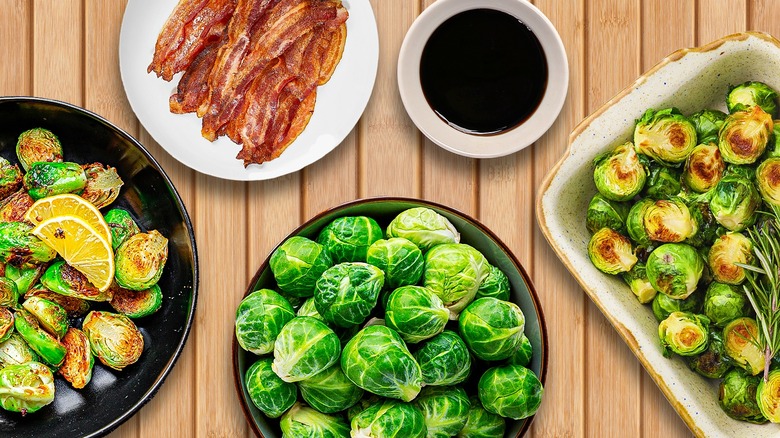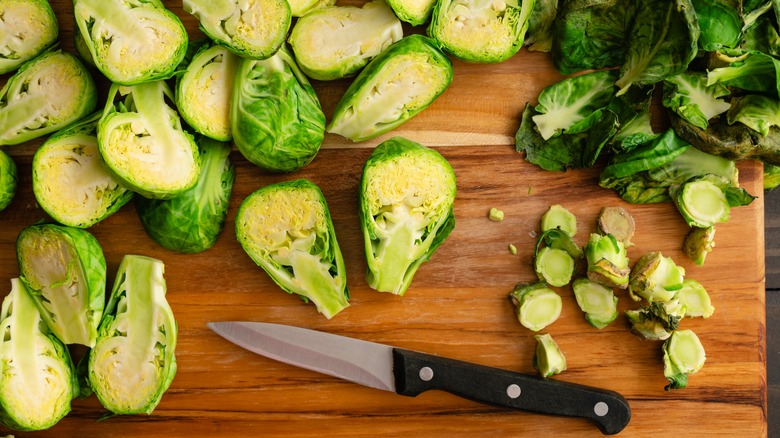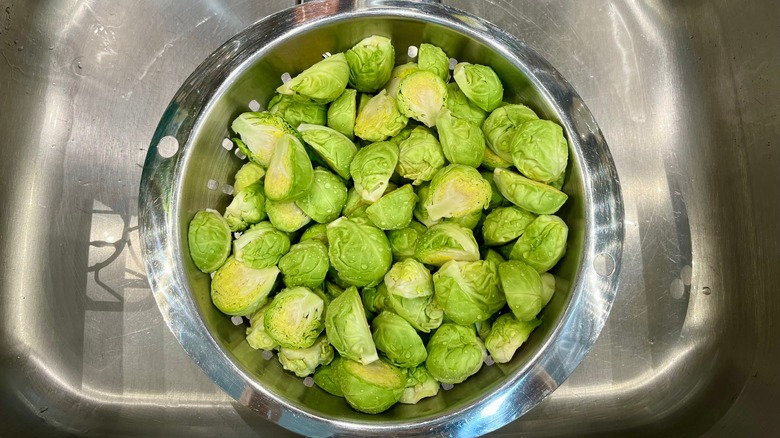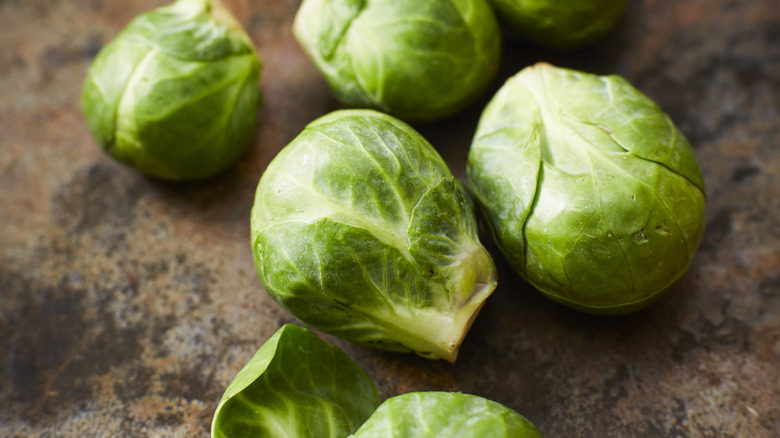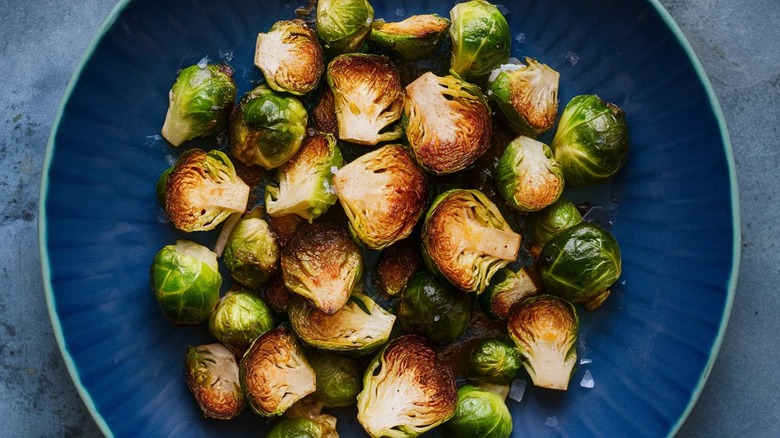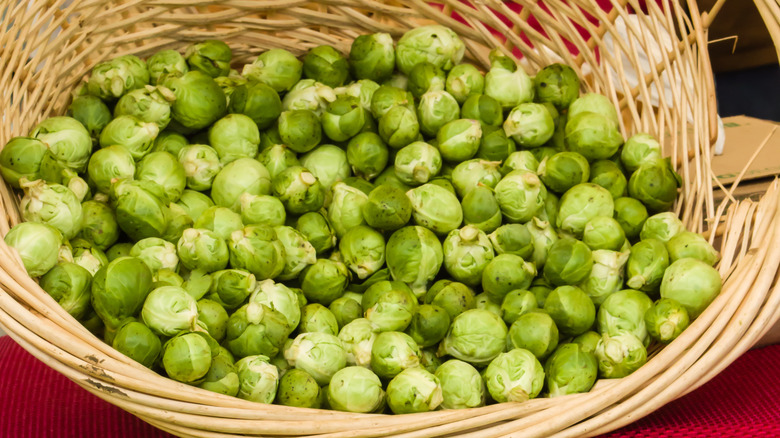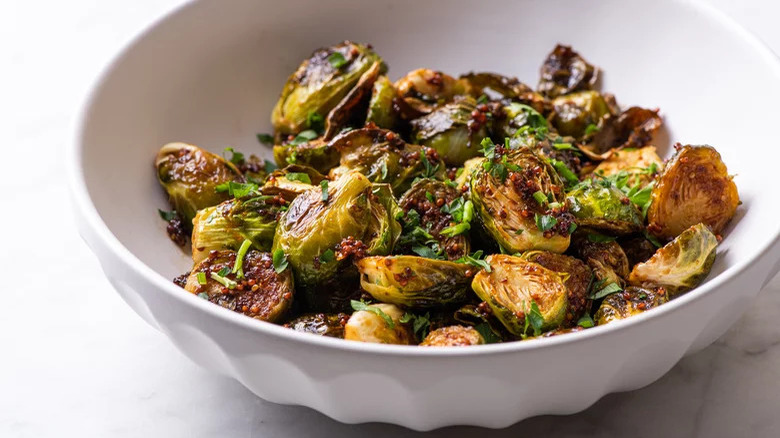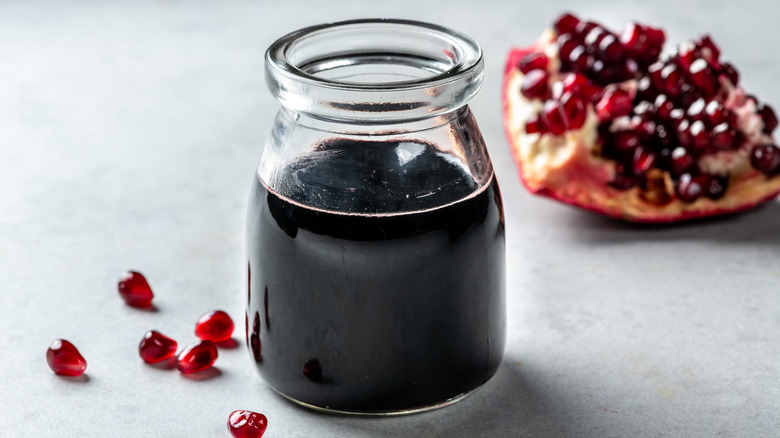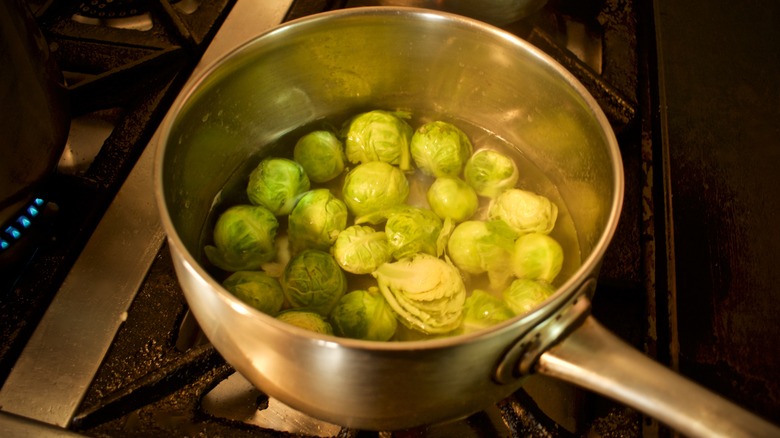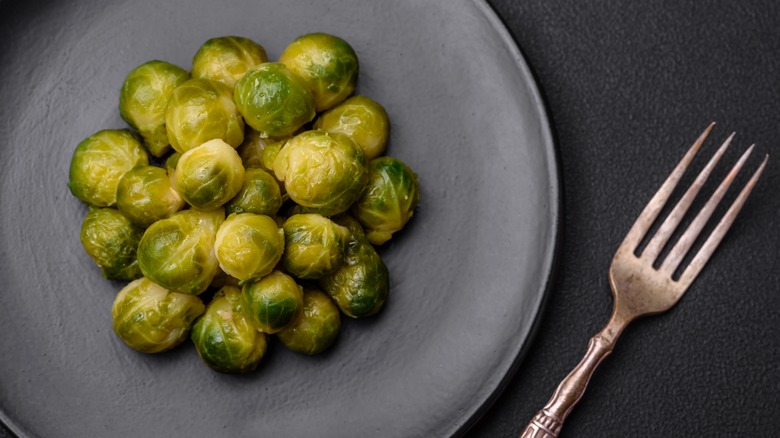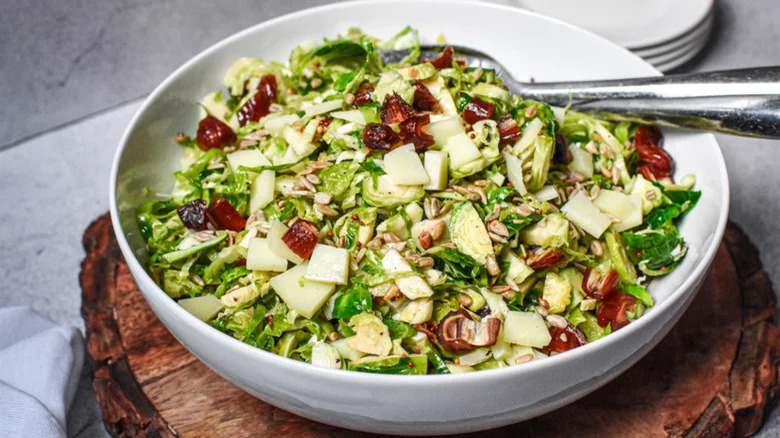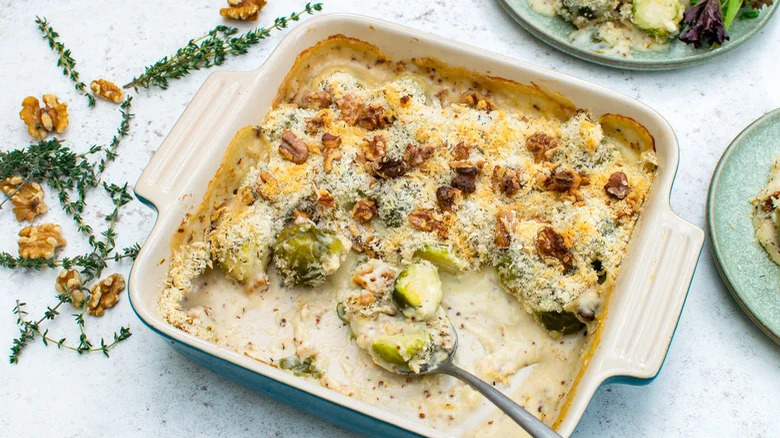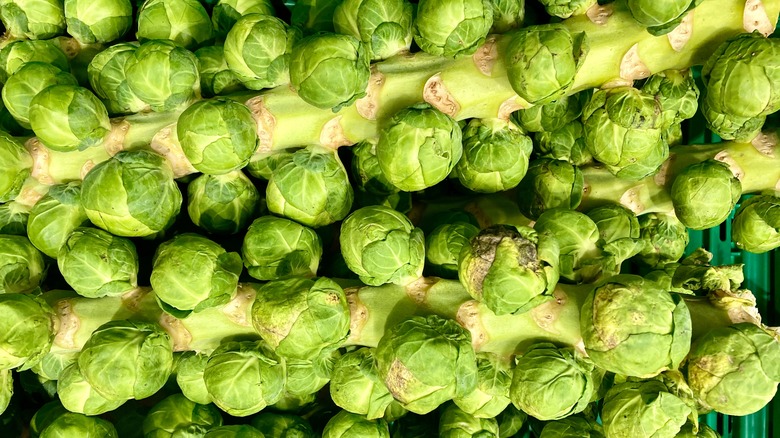14 Mistakes That Are Ruining Your Brussels Sprouts
Brussels sprouts are a fantastic vegetable to integrate into your meals because they're widely available and highly versatile. You can find them on the stalk, prepped in bags, in the freezer section, and more to find an option that works best for what you're making. The round veg can be mixed in as part of your meal or served as a side, but you're highly likely to encounter issues that might make you second guess using them. We're here to give you some fixes with the help of a couple of experienced cooks.
Scott Groth is a professional chef and the creator of I'd Rather Be a Chef. "Having worked extensively with Brussels sprouts in various forms, I've encountered many common mistakes home cooks make that ruin their potential," Groth shares. We also spoke with Marissa Stevens, the food blogger behind Pinch and Swirl. "I've learned how to bring out their best, turning even skeptics into fans," says Stevens.
Whether you detest the bitterness, need help effectively roasting your sprouts, or want to enhance the seasoning, most of us have experienced at least one (if not several) of the worst mistakes that are ruining your Brussels sprouts. Keep reading, and you'll be able to apply practical tips to fix any errors right away.
Not trimming them correctly
There is a delicate balance when it comes to trimming Brussels sprouts. You can easily chop off too many leaves or cut too much from the stem, leaving just a nub to work with while its leaves fall off with every movement. Or you might pop them off the stalk without any trimming and wonder why they're so chewy and difficult to work with. Even store-bought bagged or frozen sprouts may still need maintenance.
The prep work can be a turn-off, but we promise it's an error to avoid it altogether. Plus, it's easier to manage when you understand how to work with the sprouts (not against them). You will need to cut off the stem and some of the leaves. There's no exact guideline, but generally, you'll want to take off the outer leaves of the Brussels sprout and chop the stem so it reaches the bud. You'll find the right equilibrium with experience. You can also score an "x" at the base to help them cook evenly. Proper trimming can deliver better results, no matter what you plan to make with them.
Forgetting to wash and dry them
Don't skip washing your sprouts. Fresh produce, whether vegetables or fruits, should be cleaned before ingesting. This helps remove bacteria, microbes, bugs, and trace chemicals so you can have a safer eating experience. You don't need any fancy equipment or fruit washes; you simply need a bowl filled with water. But you could add ½ cup of distilled white vinegar for every cup of water if you want extra strength. It helps if they're already trimmed because you don't need to wash the outer leaves or stems if they're just going to get chopped off.
Place the sprouts in the water so they're fully submerged, and rub them to remove dirt or debris. If you look in the bowl, you might notice sediment, maybe a small bug or two. Once you've gone through all the veggies, rinse them under running water. After washing them, it's crucial to fully dry Brussels sprouts before roasting to remove moisture. Pat them dry and lay them on a clean kitchen towel. This allows you to have more control over the texture when cooking. Wet sprouts mean you'll have a soggy result, which isn't what you're going for when roasting.
Using old sprouts
It's easy to forget produce when it's hidden in the fridge or freezer. But it's a mistake to expect old sprouts to have peak results. The old ones can impact the flavor and texture of your dish for a less-than-desirable outcome. Luckily, it's pretty easy to tell which is which. Old Brussels sprouts may have bruising or mushy bits, while fresh ones are firm and green. If they show signs of yellow or brown, you'll know that they're past their prime. While you can use sprouts with wilted or yellow leaves, just note that they might not be as tasty.
Before cooking them, though, remove the outer leaves to see if the inside is still fresh. If they have a fishy or strong odor or are brown or soggy on the inside, toss them out immediately. For best results, store your sprouts in the fridge to avoid yellowing or spoiling, but somewhere you can still see them. Don't wash or trim them until you're ready to use them. The freshness of your veggies can truly make them more tasty.
Overcrowding the pan
Not giving the sprouts enough space when roasting can be a huge blunder in the final result. Roasting entails putting the oven at a high temperature, somewhere around 425 degrees Fahrenheit for 20 to 30 minutes. Slice them in half or leave them whole. Just make sure you don't crowd the pan or else you might have steamed sprouts instead of the crunchy roasted ones you were expecting because it "prevents the sprouts from developing that rich, caramelized exterior," Scott Groth explains. Spread the round vegetables out in a single layer and allow them enough space to get some airflow. "This ensures a crisp, golden-brown finish while maintaining the tender inside," says Groth.
If you prepped a lot and it looks like they'll be crammed, there's a solution for that, too. "I like to use two baking sheets if needed, rotating them halfway through cooking," Marissa Stevens shares. This way, you can get everything cooked simultaneously without having to work in batches. You'll know the sprouts are ready when they're tender when poked with a fork and have a brown, crispy exterior.
Mixing up the sizing and expecting consistent results
Your fresh or frozen sprouts may have sizing variations, which is normal, but they won't cook at the same rate. They can range in size from egg-sized to nickel-sized, so it's an oversight not to factor in the difference between small and large Brussels sprouts. It can mess up the cooking time, preparation, and even the flavor of your veggies. Larger ones have a more prominent bitter, cruciferous flavor and may need to be sliced in half to ensure even cooking. This size may have looser center leaves compared to the smaller sprouts that are often sweeter and denser.
Mixing and matching the sizing may result in some being firm while others are fork-tender. If you've ever followed a Brussels sprouts recipe and found the cooking times to be completely off, the sizing may be the reason. It helps to lump the sizes together so they'll cook evenly and have a comparable taste. If your store or farmers market sells bulk sprouts that you can pick yourself, select ones that have a similar size. But if you purchased a stalk or bagged sprouts, you might yield a smaller dish based on using same-sized Brussels.
Underseasoning or sticking with seasoning classics
We all know that salt and pepper go together, but you may want to branch out when seasoning your sprouts. There's a world of flavor out there, and it's a mistake to stick to the basics or, worse, underseason the green bites entirely. "Sprouts need bold seasonings to bring out their natural flavor," Scott Groth says. Try using balsamic vinegar, honey, soy sauce, garlic, Sriracha, or smoked paprika, but you can pick from nearly anything you have on hand.
Balsamic roasted Brussels sprouts have a bit of everything, with whole grain brown mustard, maple syrup, balsamic vinegar, hot sauce, and a fresh parsley garnish. There are plenty of variations, so you can make balsamic ones this time and then assemble a fried Brussels sprout salad with a sambal and fish sauce dressing the next. You should also factor in ample oil or butter when cooking so it's fully coated. The fat works to brown the outer layers when searing and boosts the overall taste of the veggies. Don't rob your sprouts of their full flavor potential. There are so many mouthwatering ways to make them and change your mind about Brussels sprouts. As Marissa Stevens puts it, you might "come to love these little cabbages."
Forgetting to add a sweet component
Sweetening your Brussels sprouts can give them an extra punch when you want to make a dish that people will remember. And you don't have to stick to things like honey, maple syrup, or agave. We have a few interesting ways to integrate a sweet profile into your meal that you might not have thought of. Orange or grape juice can naturally enhance your round veggies in a new way while adding a liquid component.
Pomegranate molasses is the sweet addition your Brussels sprouts need when you want a captivating complement that brings more than sweetness. The pomegranate juice reduction, which you'll frequently see in Middle Eastern cuisine, is also tart. This makes an excellent choice for any sprouts, but it also provides dimension with its sweet and acidic notes.
Pair the little orbs with caramelized sweet potato to create a savory pastry dish that's satisfying for any meal. The pie dough shells make a crisp base for a bite-sized dish that is sweet, tangy, and nutty. Add chopped peaches to cooked sprouts for a tasty side to put out for picnics or family gatherings. The sweet ingredient brings a balance of flavors when you want a more complex option. It's a mistake to think of these veggies as savory-only food.
Not trying out different cooking methods
Don't stick to one cooking method. It can be beneficial to use different ones for your sprouts. Each technique can yield distinct results and textures. Boiling or steaming provides a soft option. These can be top prospects when you don't need a crunch factor or don't want the extra oil you need to roast or sautee them.
Roasting brings a crunchy exterior with brown outer leaves. This can also help "bring out their natural sweetness and create a delicious caramelized exterior," says Marissa Stevens. Before roasting or pan-searing the vegetables, it helps to pre-boil larger sprouts for three to four minutes. This aids in softening the center "while allowing the high heat to create a crispy outer layer," Scott Groth explains.
To achieve better results, keep the Brussels sprouts on high heat for sauteeing, roasting, and frying. A low temperature is a common mistake that can lead to watery sprouts (which probably isn't what you're going for). Roast them at a higher temperature of 400 to 425 degrees Fahrenheit or pan-fry them for a brown, charred exterior. As long as it still has a tender inside, don't fret if you see it and think it's burned.
Overcooking your sprouts
Although there are a few ways to heat the leafy green treats, it's a mistake to overcook them. Overcooking is ultimately one of the biggest mistakes that is ruining your Brussels sprouts. There's a fine line between boiled sprouts and a mushy mess, roasted ones and fully burned ones, and so on. Marissa Stevens shares that boiling them into oblivion is probably the number one mistake but can be easily fixed. This is because boiling often leads to "waterlogged, bitter sprouts" that just might be the reason the veg gets a bad rap. This is when you might notice that off-putting sulfur aroma that's often associated with the green morsels.
But you might come across a couple of issues when baking, roasting, searing, or other forms of cooking. "Burned or squishy sprouts are equally unappealing," Stevens says. While charred or extra crispy sprouts might be a delight, there's a point when it's just a tough, dry, incinerated mess. If you're seeking that crisp exterior, then aim for "a tender but not mushy interior." You can test check out the doneness by poking them with a fork.
Only eating them cooked
Roasted or sauteed sprouts may be a common way to cook your round, green vegetables, but you'll miss out if you don't eat them raw. We will preface that this may not be a good option for everyone as eating them raw can increase gas because of the veggie's raffinose, which is an indigestible fiber. If you're particularly susceptible to gas or have digestive conditions, skip this tip. That said, raw Brussels sprouts can be delicious and versatile when prepared correctly, but you don't want to chomp into one like you would an apple.
Enjoy raw Brussels sprouts sliced, shaved, or separated by the leaf, which you can do by trimming the stem and gently peeling off the leaves. You may need to trim the stem further to release more leaves, Marissa Stevens explains. For sliced sprouts, "the slicing disc of your food processor is a real time-saver," says Stevens. Try the veg in a shaved Brussels sprouts salad that deliciously blends sweet and savory with a dressing made from red wine vinegar, honey, olive oil, and whole grain mustard. There's the caramel sweetness of chopped dates paired with the nutty milkiness of Manchego cheese.
Omitting the bacon
Lots of recipes pair Brussels sprouts and bacon together. Ever wonder why that is? They make an incredible combination because the bacon adds a salty, smoky crunch to cooked or raw sprouts. Bacon has a concentrated flavor that's notable and prominent. Whether you opt for crumbles or larger pieces, you can taste and feel it even if you have the smallest nibble.
Broccoli bacon Brussels salad combines raw vegetables, sliced bacon, and nuts to create a crunchy salad. This is an ideal option to test out if the boiled vegetables of your childhood scarred you. It's full of vibrant colors, balanced flavors, and, of course, plenty of texture. Nothing wilted here. Make the bacon-Brussels duo a star appetizer by making bacon-wrapped balsamic Brussels sprouts for a party. You can hardly tell the veggie is in there as it's covered in smoky bacon and sweet and tangy balsamic; it may be a surprise favorite amongst kids or Brussels sprout haters. Overlooking this addition might be the missing ingredient for a dish that wows.
Skipping the sauce
"Brussels sprouts can handle bold flavors," says Marissa Stevens. Sauces can make a huge improvement in the overall potential of your sprouts dish. It's a forgiving choice, especially if you're working with overcooked veggies or ones that aren't as fresh. But it's also great when you want added flavor that seasoning alone can't accomplish.
Buffalo sauce is an easy choice since it packs a punch with notes of vinegar, garlic, and spices from the hot sauce. Or reach for something creamy. Make Brussels sprouts gratin with a cheesy, decadent bechamel sauce. While you may be familiar with the potato-based version of the dish, this one brings a fresh option to serve alongside meats or a vegetarian meal. Stevens suggests enjoying them in a meat-free Kung Pao dish "that even dedicated carnivores would love."
Don't be afraid to test the boundaries of the sauces, as they won't swamp the vegetable. This mistake, once rectified, can turn bland Brussels sprouts into a wholly appealing piece of your meal, if not the star. The veg is "incredibly adaptable and can take on a variety of flavor profiles," Stevens explains.
Thinking that bitterness is something you have to battle through
The green veggie is often associated with being a yucky, astringent side dish that reeks of sulfur. They are cruciferous vegetables with a sulfur-containing compound called glucosinolates, which is likely where the negative associations come from. And while they may have a particular smell and taste, there are practical ways to lessen any offensive flavors. It doesn't have to be a struggle to swallow as they can have a mild, almost sweet taste when cooked.
Parboil your Brussels sprouts in salt water to reduce their bitter bite, "making for a more balanced flavor," Scott Groth shares. This doubles as a time-saving hack to shorten the cooking time. However, stick to a two-minute boil and then roast or saute them. The parboiling helps to soften the insides while allowing the high temperatures to crisp up the exterior.
There are other ways to ameliorate the bitterness if boiling isn't to your liking. Prepping and cleaning them correctly can help get rid of exterior leaves. You can also rely on seasonings such as acid, fat, sugar, or salt. Sauces and thorough seasoning can not only bring pizzazz to the dish but also make any bitterness all the more palatable. Experiment with ingredients that add "layers of complexity, balancing the slight bitterness with sweetness or umami," says Groth.
Neglecting the stalks
During the trimming process, you usually toss out the stems, outer leaves, and stalk. But you should consider keeping the stalk and cooking it. It's a missed opportunity since it's not only edible but genuinely tastes delicious — similar to artichoke hearts. As a bonus, it also reduces waste. After popping the sprouts off the stalk, wash the stalk to get rid of any dirt. Then, use a serrated knife to cut it into smaller pieces. You can approach cooking them in a few ways, whether you boil them in a flavorful stock or pop them in a multi-cooker.
Once they're tender, slice them lengthwise and scoop out the insides. It's kind of like eating bone marrow but more along the lines of Brussels marrow. The outer portion is fibrous, but the core is soft. The final result is an unexpected way to use a part of the plant that you often see thrown away. You could peel the stalk, cut it into pieces, and roast it along with the rest of the Brussels, but this can be a time-consuming task. Eating the stalks can provide a new texture to your meal, especially if you like experimenting with ingredients.
